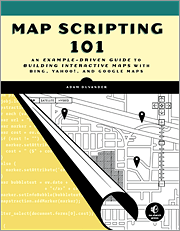 |
San Francisco, CA, August 17, 2010—Web applications like MapQuest and Google Maps simplify the way we navigate, offering nearly instant directions to the closest dentist, auto mechanic, or happy hour spot. For developers looking to incorporate an innovative, useful tool into their application or website, an interactive map can spur interest and encourage repeat visits from users. But how does the beginning cartographer take the plunge?
Map Scripting 101 (No Starch Press, Aug 2010, 376 pp, $34.95, ISBN 9781593272715) is an example-based beginner's guide to map scripting. Author Adam DuVander delivers a cookbook of 73 immediately useful mapping scripts like a local concert tracker, a Twitter friend-finder, and a real-time weather map. And because the book is based on the cross-platform Mapstraction JavaScript library, readers can use virtually any mapping service, including OpenStreetMap, MapQuest, Google Maps, Yahoo!, and Bing.
"When I show web developers how easy it is to make insightful online mashups and maps, the most common reaction is shock and delight. I love showing readers how powerful these geographic tools can be," says DuVander.
As they make their way through Map Scripting 101, readers learn how to:
- Create, embed, and manipulate basic maps by setting zoom levels and map boundaries
- Show, hide, and filter location markers and info-bubbles
- Customize maps for visitors based on their location
- Use common data formats like Google Earth's KML, GeoRSS, and GPS XML (GPX)
- Create graphical overlays on maps to better analyze data and trends
- Use freely available geodata from websites like Yelp and Upcoming—and public domain geodata from the US government
Map Scripting 101 is accessible enough for those with just a basic knowledge of HTML and CSS, but even advanced programmers will learn something new. Whether readers want to mark the best brasseries in gay Paris or just map their local police blotter, Map Scripting 101 provides bloggers, developers, and designers with the knowledge they need to create useful, interactive maps.
For more information or to request a review copy of Map Scripting 101, contact Natasha Chilingerian at No Starch Press (nostarchpr@oreilly.com, +1.415.863.9900, x301), or visit www.nostarch.com.
About the Author
Adam DuVander writes about geolocation, web development, and APIs for Programmable Web and WebMonkey, Wired.com's web developer resource. He has presented his work at SXSW and O'Reilly's Where 2.0 conference. He lives at 45° 33' 25" N, 122° 31' 55" W (otherwise known as Portland, Oregon).
Additional Resources
Chapter 2: "Plotting Markers and Message Boxes" (PDF)
Table of contents overview
Detailed table of contents (PDF)
Index (PDF)
http://nostarch.com/mapscripting.htm
Map Scripting 101
by Adam DuVander
August 2010, 376 pp.
ISBN 9781593272715, $34.95 USD
order@oreilly.com
1-800-998-9938
1-707-827-7000
Available in fine bookstores everywhere, from www.oreilly.com/nostarch, or directly from No Starch Press (http://www.nostarch.com, orders@nostarch.com, 1-800-420-7240).
About No Starch Press
Founded in 1994, No Starch Press is one of the few remaining independent computer book publishers. We publish the finest in geek entertainment—unique books on technology, with a focus on open source, security, hacking, programming, alternative operating systems, LEGO, science, and math. Our titles have personality, our authors are passionate, and our books tackle topics that people care about. Visit http://www.nostarch.com for a complete catalog.
About O’Reilly
O’Reilly Media spreads the knowledge of innovators through its books, online services, magazines, and conferences. Since 1978, O’Reilly Media has been a chronicler and catalyst of cutting-edge development, homing in on the technology trends that really matter and spurring their adoption by amplifying “faint signals” from the alpha geeks who are creating the future. An active participant in the technology community, the company has a long history of advocacy, meme-making, and evangelism.